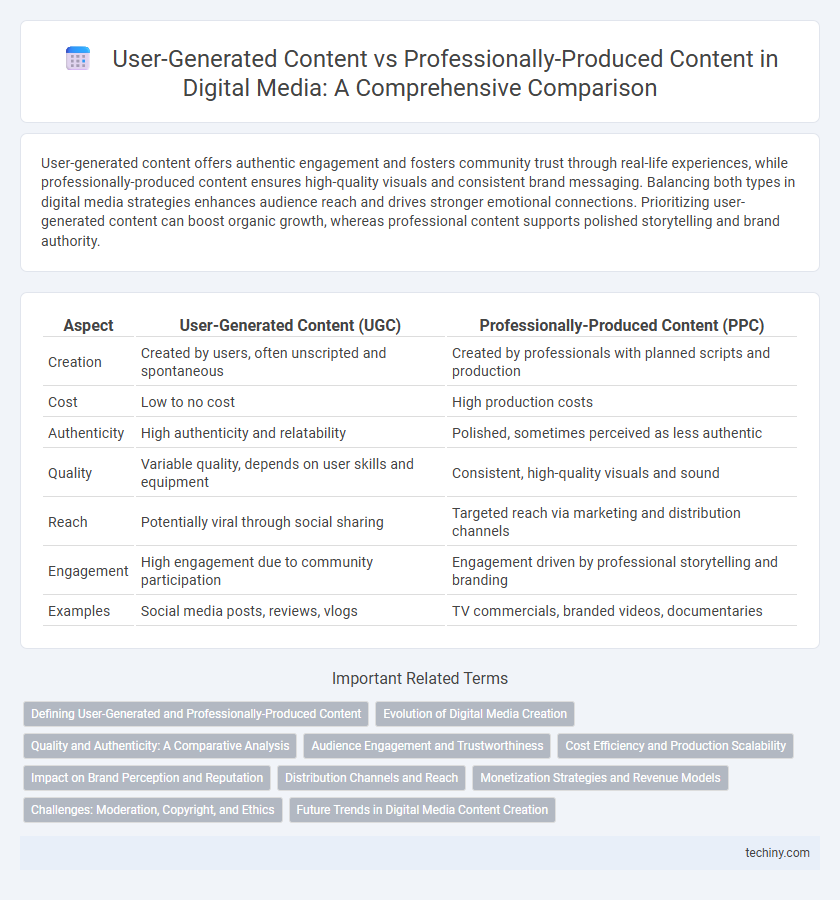User-generated content offers authentic engagement and fosters community trust through real-life experiences, while professionally-produced content ensures high-quality visuals and consistent brand messaging. Balancing both types in digital media strategies enhances audience reach and drives stronger emotional connections. Prioritizing user-generated content can boost organic growth, whereas professional content supports polished storytelling and brand authority.
Table of Comparison
| Aspect | User-Generated Content (UGC) | Professionally-Produced Content (PPC) |
|---|---|---|
| Creation | Created by users, often unscripted and spontaneous | Created by professionals with planned scripts and production |
| Cost | Low to no cost | High production costs |
| Authenticity | High authenticity and relatability | Polished, sometimes perceived as less authentic |
| Quality | Variable quality, depends on user skills and equipment | Consistent, high-quality visuals and sound |
| Reach | Potentially viral through social sharing | Targeted reach via marketing and distribution channels |
| Engagement | High engagement due to community participation | Engagement driven by professional storytelling and branding |
| Examples | Social media posts, reviews, vlogs | TV commercials, branded videos, documentaries |
Defining User-Generated and Professionally-Produced Content
User-generated content (UGC) refers to digital media created and shared by individuals rather than brands or professionals, often characterized by its authenticity and grassroots nature. Professionally-produced content involves media developed by skilled creators or organizations using advanced tools and industry standards to ensure high quality and strategic messaging. Understanding these definitions highlights the distinctions in production value, intent, and audience engagement between UGC and professionally-produced content.
Evolution of Digital Media Creation
User-generated content has revolutionized digital media creation by enabling diverse voices to contribute authentic, real-time perspectives, dramatically expanding content variety and engagement. Professionally-produced content maintains high production quality, leveraging specialized skills and technology to deliver polished narratives and brand-consistent messaging. The evolution of digital media creation increasingly blends these approaches, with platforms integrating user-generated authenticity and professional storytelling to captivate wider audiences.
Quality and Authenticity: A Comparative Analysis
User-generated content often excels in authenticity by reflecting genuine consumer experiences and fostering community trust, yet it may lack the high production quality found in professionally-produced content. Professionally-produced content delivers polished visuals and precise messaging aligned with brand standards, enhancing credibility and engagement through superior technical execution. Balancing user-generated authenticity with professional quality allows digital media strategies to capitalize on emotional connection while maintaining a consistent, high-quality brand image.
Audience Engagement and Trustworthiness
User-generated content (UGC) often drives higher audience engagement by fostering authenticity and relatability, encouraging deeper interaction and community building. Professionally-produced content generally maintains greater trustworthiness through polished presentation and verified information, appealing to audiences seeking credibility and expert insights. Balancing UGC's emotional connection with professional content's reliability optimizes overall digital media strategies for enhanced audience retention.
Cost Efficiency and Production Scalability
User-generated content significantly reduces production costs by leveraging audience participation without the need for expensive equipment or professional teams, enhancing cost efficiency. Its inherent scalability allows brands to rapidly increase content volume through diverse contributions, adapting quickly to market demands. In contrast, professionally-produced content, while higher in quality, often incurs substantial expenses and longer production timelines, limiting scalability and budget flexibility.
Impact on Brand Perception and Reputation
User-generated content enhances brand authenticity and fosters community trust by showcasing genuine customer experiences, often driving higher engagement and loyalty. Professionally-produced content maintains consistent quality and messaging, reinforcing brand authority and credibility in competitive markets. Brands leveraging both types benefit from a balanced reputation, combining relatability with polished professionalism to optimize consumer perception.
Distribution Channels and Reach
User-generated content often thrives on social media platforms like TikTok, Instagram, and YouTube, benefiting from viral sharing and direct audience engagement that amplifies reach organically. Professionally-produced content typically leverages established distribution channels such as television networks, streaming services, and branded websites, ensuring wider initial exposure through strategic marketing and paid promotions. The combination of grassroots user-generated content with the expansive infrastructure of professional media drives diverse audience reach and enhanced content discoverability in digital ecosystems.
Monetization Strategies and Revenue Models
User-generated content (UGC) leverages low production costs and community engagement to generate revenue through advertising, affiliate marketing, and sponsored posts, capitalizing on high authenticity and user trust. Professionally-produced content relies on subscription models, pay-per-view, and licensing agreements, driving monetization by offering premium quality and exclusive access. Hybrid strategies blend UGC's viral reach with professional content's polished appeal, optimizing revenue streams across diverse digital media platforms.
Challenges: Moderation, Copyright, and Ethics
User-generated content presents significant challenges in moderation due to its volume, variability, and potential for harmful or misleading material, requiring advanced AI and human oversight. Copyright issues frequently arise as users often share copyrighted works without proper authorization, complicating enforcement and content removal. Ethical concerns include the spread of misinformation, privacy violations, and content that may exploit vulnerable populations, demanding clear policies and responsible platform governance.
Future Trends in Digital Media Content Creation
User-generated content (UGC) is projected to dominate digital media with advancements in AI-driven content creation tools that enable wider accessibility and creativity. Professional content production will increasingly integrate immersive technologies like virtual reality (VR) and augmented reality (AR) to deliver highly engaging and personalized experiences. The convergence of UGC and professional content, supported by blockchain for content authenticity and monetization, will reshape digital media ecosystems by fostering collaboration and trust.
user-generated content vs professionally-produced content Infographic

 techiny.com
techiny.com